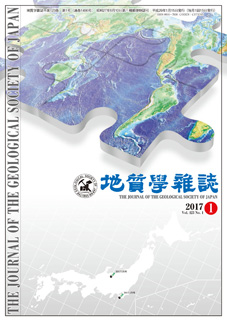
- |<
- <
- 1
- >
- >|
-
Hironao Shinjoe, Yuji Orihashi2021Volume 127Issue 10 Pages 595-603
Published: October 15, 2021
Released on J-STAGE: January 01, 2022
JOURNAL FREE ACCESS
Supplementary materialThe Miocene Kuma Group, which is mainly distributed south of the Median Tectonic Line (MTL) in western Shikoku, has a stratigraphic record of internal deformation during the opening of the Japan Sea that has attracted much attention in discussions of movement along the MTL. The upper part of the Kuma Group has been dated as lower-middle Miocene on the basis of radiometric ages of the acidic tuffs in the Myojin Formation. However, previously reported ages are considerably dispersed. In this study, U-Pb ages were determined by laser ablation inductively coupled mass spectrometry of zircons from an acidic tuff, yielding a weighted average 238U-206Pb age of 15.19±0.15 Ma. This dating suggests that the Myojin Formation was probably deposited during the middle Miocene, shortly before the eruption forming the igneous rocks of the Ishizuchi Group, which is constrained by zircon U-Pb ages at 14.2-14.8 Ma. This is consistent with the occurrence of peperite in the Kuma Group, which shows that the time gap between deposition of the Kuma Group and emplacement of the Ishizuchi Group is quite small. Since the U-Pb age of the acidic tuff overlaps with the age range of the Outer Zone Granites, the tuff may be derived from effusive phases of the Outer Zone Granites.
View full abstractDownload PDF (2272K) -
Keisuke Eshima2021Volume 127Issue 10 Pages 605-619
Published: October 15, 2021
Released on J-STAGE: January 01, 2022
JOURNAL FREE ACCESS
Supplementary materialIn the northern part of Mt. Shaku-dake (Kitakyushu city, Fukuoka prefecture, SW Japan), porphyritic fine-grained tonalite and clinopyroxene quartz diorite intrude the Cretaceous Wakino sub-group as stocks. Previous geochronological studies have suggested that the tonalite magma formed prior to intrusion of the diorite magma, in advance of the large-scale igneous activity that created the Northern Kyushu granitic batholith. The tonalite is exposed over a wide area extending ~5 km from east to west and 3 km from north to south. The tonalite shows a peperitic texture at the boundary with the host rock (the Wakino sub-group), and the presence of secondary minerals and veins due to hydrothermal alteration in the tonalite suggest that the whole-rock compositions have been modified. Geochemical modeling reveals that owing to hydrothermal alteration, the tonalite gained SiO2, Al2O3, and K2O, and lost CaO and Na2O. The diorite, however, has sharp boundaries where it intrudes the Wakino sub-group and the tonalites. The petrological features of the rocks suggest that the magma evolved through fractional crystallization, crystal accumulation, and mixing in a magma chamber. Evidently, the Cretaceous igneous activity in northern Kyushu began with shallow-level magmatism forming the intrusive porphyritic (or volcanic) rocks represented by the tonalite, followed by hydrothermal activity, and culminating with the emplacement of large-scale batholiths from stock-like plutonic activity.
View full abstractDownload PDF (9086K) -
Tokiyuki Sato, Ryo Kato, Shun Chiyonobu2021Volume 127Issue 10 Pages 621-633
Published: October 15, 2021
Released on J-STAGE: January 01, 2022
JOURNAL FREE ACCESSWe studied in detail the middle Miocene NN5 and NN6 calcareous nannofossil assemblages of the Nanatani Formation for reconstruction of the paleoceanography of the Niigata oil field.
The wide area located in the Niigata plain from Mitsuke to Yahiko-Teradomari is interpreted as an area of non-marine paleoenvironments during the deposition of the NN5 to NN6 zones, which is consistent with the previous seismic stratigraphic interpretation.
In addition, abundant NN5 calcareous nannofossils related to the main ocean current system are found in the area from the southeast to northeast along the Shibata-Koide tectonic line. The abundance decreased in the NN6 zone, which was paralleled with the shrinkage of the marine area within the Niigata basin. The timing of this environmental change between the NN5/NN6 is correlated to a cooling event shown by Holbourn et al. (2013) just after the Mid-Miocene Climatic Optimum, and hence the fall of the global sea level. This indicates that the environment changes in the late Nanatani Age were strongly influenced by the middle Miocene global climatic event.
Furthermore, the NN5 and NN6 calcareous nannofossils are absent in the oil and gas fields, which are characterized by Miocene volcanic reservoirs. This evidences that the topographic relieves around the oil and gas fields today already existed prior to the time of the deposition of the NN5 zone. This suggests that the general framework of the oil and gas-bearing structures would have been established as a consequence of the rifting and rift-related volcanism during the opening of the Japan Sea.
View full abstractDownload PDF (8456K) -
Susumu Tanabe2021Volume 127Issue 10 Pages 635-648
Published: October 15, 2021
Released on J-STAGE: January 01, 2022
JOURNAL FREE ACCESSThe paleo-Tokyo, Naka, Ara, and Tama river valleys were formed beneath the central area of the Kanto Plain during the Last Glacial Maximum (LGM). These incised valleys run parallel to the northwest-southeast trending geological structure of the Median Tectonic Line. Branches of these incised valleys dissect the upper Pleistocene uplands that surround the coastal lowlands. At least four buried terraces were identified in the study area, referred to as Omiya marine isotope stage (MIS) 5c, T1 (MIS 5a), T2 (MIS 3), and T3 (early LGM) surfaces. The Omiya surface rises toward the west in the northern part of the study area beneath the Kazo Lowland, possibly as a result of uplift along the Ota fault.
View full abstractDownload PDF (9311K)
-
Koji Shimada, Akira Goto, Masakazu Niwa, Michito Shimo2021Volume 127Issue 10 Pages I-II
Published: October 15, 2021
Released on J-STAGE: January 01, 2022
JOURNAL FREE ACCESSDownload PDF (3832K)
-
Kenshiro Otsuki2021Volume 127Issue 10 Pages 650
Published: October 15, 2021
Released on J-STAGE: January 01, 2022
JOURNAL FREE ACCESS
- |<
- <
- 1
- >
- >|